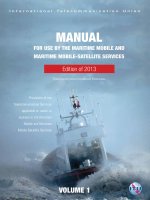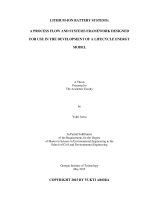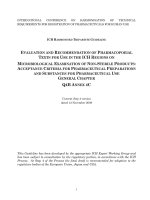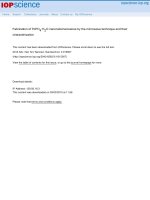MANUAL FOR USE BY THE MARITIME MOBILE AND MARITIME MOBILE SATELLITE SERVICES VOL 2
Bạn đang xem bản rút gọn của tài liệu. Xem và tải ngay bản đầy đủ của tài liệu tại đây (3.39 MB, 624 trang )
edition OF 2013
1
r n
i onnaal l
I nI tn et re n
a at ti o
e ll e
e c
t it oi n
o ino n
TT e
co
om
mm
muunni c
i ca a
o nU nUi n
Manual
for use by the Maritime Mobile and
International Telecommunication Union
Sales and Marketing Division
Place des Nations
CH-1211 Geneva 20
Switzerland
www.itu.int/publications
*36519*
*38428*
Printed in Switzerland
Geneva, 2013
ISBN 978-92-61-14341-1
ISBN xxxxxxxx
Photo credits: Photo
Philip Plisson
credits:
Shutterstock,©
ITU/K.
ITU/K.
Bogens
Bogens
©
Manual
byMaritime
the Maritime
Mobile
and
Maritime Mobile-Satellite
Services
Manual forfor
use use
by the
Mobile and
Maritime
Mobile-Satellite
Services English edition
2011
Maritime Mobile-Satellite Services
Provisions of the Telecommunication
Services applicable or useful to stations
Edition of 2013
in the Maritime Mobile and Maritime
Mobile‑Satellite
Services
Radiocommunication Bureau
Provisions of the
Telecommunication Services
applicable or useful to
stations in the Maritime
Mobile and Maritime
Mobile‑Satellite Services
Volume 1
English edition 2011
Volume 2
Radiocommunication Bureau
I n t e r n a t i o n a l
T e l e c o m m u n i c a t i o n
U n i o n
Manual
for use by the Maritime Mobile and
Maritime Mobile-Satellite Services
Volume 2
ENGLISH EDITION 2013
Radiocommunication Bureau
THE RADIOCOMMUNICATION SECTOR OF ITU
The role of the Radiocommunication Sector is to ensure the rational, equitable, efficient
and economical use of the radio-frequency spectrum by all radiocommunication
services, including satellite services, and carry out studies without limit of frequency
range on the basis of which Recommendations are adopted.
The regulatory and policy functions of the Radiocommunication Sector are performed
by World and Regional Radiocommunication Conferences and Radiocommunication
Assemblies supported by Study Groups.
Inquiries about radiocommunication matters
Please contact:
ITU
Radiocommunication Bureau
Place des Nations
CH -1211 Geneva 20
Switzerland
Telephone:
Fax:
E-mail:
Web:
+41 22 730 5800
+41 22 730 5785
www.itu.int/itu-r
Placing orders for ITU publications
Please note that orders cannot be taken over the telephone. They should be sent
by fax or e-mail.
ITU
Sales and Marketing Division
Place des Nations
CH -1211 Geneva 20
Switzerland
Fax:
E-mail:
+41 22 730 5194
The Electronic Bookshop of ITU: www.itu.int/publications
ITU 2013
All rights reserved. No part of this publication may be reproduced by any means whatsoever,
without the prior written permission of ITU.
Table of Contents
iii
TABLE OF CONTENTS
Manual for use by the maritime mobile and
maritime mobile-satellite services
Page
FOREWORD
............................................................................................
1
PART A
Extracts from the Constitution and Convention of
the International Telecommunication Union
Constitution (CS) of the International Telecommunication Union
CHAPTER VI – General Provisions Relating to Telecommunications
ARTICLE 33 The Right of the Public to Use the International
Telecommunication Service .................................................
5
ARTICLE 34 Stoppage of Telecommunications ........................................
5
ARTICLE 35 Suspension of Services .........................................................
6
ARTICLE 36 Responsibility .......................................................................
6
ARTICLE 37 Secrecy of Telecommunications ..........................................
6
ARTICLE 39 Notification of Infringements ...............................................
7
ARTICLE 40 Priority of Telecommunications Concerning Safety of
Life .......................................................................................
7
ARTICLE 41 Priority of Government Telecommunications ......................
7
ARTICLE 42 Special Arrangements ..........................................................
8
CHAPTER VII – Special Provisions for Radio
ARTICLE 45 Harmful Interference ............................................................
8
ARTICLE 46 Distress Calls and Messages ................................................
9
ARTICLE 47 False or Deceptive Distress, Urgency, Safety
or Identification Signals .......................................................
9
ANNEX
Definition of Certain Terms Used in this Constitution, the
Convention and the Administrative Regulations of the
International Telecommunication Union .....................................
10
iv
Maritime Manual
Page
Convention (CV) of the International Telecommunication Union
CHAPTER V – Various Provisions Related to the Operation of
Telecommunication Services
ARTICLE 36 Charges and Free Services ...................................................
12
ARTICLE 38 Monetary Unit ......................................................................
12
ARTICLE 39 Intercommunication .............................................................
13
ARTICLE 40 Secret Language ...................................................................
13
ANNEX
Definition of Certain Terms Used in this Convention and
the Administrative Regulations of the International
Telecommunication Union...........................................................
14
PART B
Extracts from the Radio Regulations (RR)
(Edition of 2012)
SECTION I – Articles (Extracts)
ARTICLE 1
Terms and definitions ...........................................................
23
ARTICLE 2
Nomenclature .......................................................................
44
ARTICLE 3
Technical characteristics of stations .....................................
46
ARTICLE 4
Assignment and use of frequencies ......................................
48
ARTICLE 5
Frequency allocations ...........................................................
51
ARTICLE 15 Interferences .........................................................................
55
ARTICLE 17 Secrecy ................................................................................
61
ARTICLE 18 Licences................................................................................
62
ARTICLE 19 Identification of stations .......................................................
64
ARTICLE 20 Service publications and online information systems ..........
77
ARTICLE 28 Radiodetermination services ................................................
79
ARTICLE 30 General provisions................................................................
82
ARTICLE 31 Frequencies for the global maritime distress and safety
system (GMDSS) .................................................................
85
Table of Contents
v
Page
ARTICLE 32 Operational procedures for distress communications in
the global maritime distress and safety system (GMDSS) ...
88
ARTICLE 33 Operational procedures for urgency and safety
communications in the global maritime distress and
safety system (GMDSS) .......................................................
102
ARTICLE 34 Alerting signals in the global maritime distress and safety
system (GMDSS) .................................................................
112
ARTICLE 46 Authority of the master ........................................................
113
ARTICLE 47 Operator’s certificates ..........................................................
114
ARTICLE 48 Personnel ..............................................................................
119
ARTICLE 49 Inspection of stations ............................................................
121
ARTICLE 50 Working hours of stations ....................................................
122
ARTICLE 51 Conditions to be observed in the maritime services .............
123
ARTICLE 52 Special rules relating to the use of frequencies ....................
129
ARTICLE 53 Order of priority of communications....................................
151
ARTICLE 54 Selective calling ...................................................................
151
ARTICLE 56 Narrow-band direct-printing telegraphy ...............................
152
ARTICLE 57 Radiotelephony ....................................................................
153
ARTICLE 58 Charging and accounting for maritime radiocommunications ...................................................................
154
SECTION II – Appendices (Extracts)
APPENDIX 1
(Rev.WRC-12) Classification of emissions and necessary
bandwidths
..................................................................
157
APPENDIX 2
(Rev.WRC-03) Table of transmitter frequency tolerances
162
APPENDIX 3
(Rev.WRC-12) Maximum permitted power levels for
unwanted emissions in the spurious domain ........................
169
Report of an irregularity or infringement .............................
179
APPENDIX 10 (Rev.WRC-07) Report of harmful interference .................
182
APPENDIX 12 Special rules applicable to radiobeacons ..............................
184
APPENDIX 14 (Rev.WRC-07) Phonetic alphabet and figure code ............
186
APPENDIX 15 (Rev.WRC-12) Frequencies for distress and safety
communications for the Global Maritime Distress and
Safety System (GMDSS) .....................................................
188
APPENDIX 9
vi
Maritime Manual
Page
APPENDIX 16 (Rev.WRC-07) Documents with which stations on
board ships and aircraft shall be provided ............................
193
APPENDIX 17 (Rev.WRC-12)
Frequencies
and
channelling
arrangements in the high-frequency bands for the
maritime mobile service .......................................................
195
APPENDIX 18 (Rev.WRC-12) Table of transmitting frequencies in
the VHF maritime mobile band ............................................
274
SECTION III – Resolutions (Extracts)
RESOLUTION 18
RESOLUTION 205
RESOLUTION 207
RESOLUTION 331
RESOLUTION 339
RESOLUTION 343
RESOLUTION 344
RESOLUTION 349
RESOLUTION 352
RESOLUTION 354
(Rev.WRC-12) Relating to the procedure for
identifying and announcing the position of ships
and aircraft of States not parties to an armed
conflict ....................................................................
283
(Rev.WRC-12) Protection of the systems
operating in the mobile-satellite service in the
band 406-406.1 MHz ..............................................
285
(Rev.WRC-03) Measures
to
address
unauthorized use of and interference to
frequencies in the bands allocated to the
maritime mobile service and to the aeronautical
mobile (R) service ..................................................
288
(Rev.WRC-12) Operation of the Global
Maritime Distress and Safety System .....................
292
(Rev.WRC-07) Coordination of NAVTEX
services ...................................................................
295
(Rev.WRC-12) Maritime
certification
for
personnel of ship stations and ship earth stations
for which a radio installation is not compulsory.....
296
(Rev.WRC-12) Management of the maritime
identity numbering resource ...................................
300
(Rev.WRC-12) Operational procedures for
cancelling false distress alerts in the Global
Maritime Distress and Safety System .....................
303
(Rev.WRC-03) Use of the carrier frequencies
12 290 kHz and 16 420 kHz for safety-related
calling to and from rescue coordination centres .....
306
(WRC-07) Distress and safety radiotelephony
procedures for 2 182 kHz .......................................
308
Table of Contents
vii
Page
SECTION IV –
ITU-R Recommendations incorporated
by reference (Extracts)
Rec. ITU-R M.489-2
Technical characteristics of VHF radiotelephone
equipment operating in the maritime mobile
service in channels spaced by 25 kHz ....................
317
Operational procedures for the use of directprinting telegraph equipment in the maritime
mobile service .........................................................
320
Operational procedures for the use of digital
selective-calling equipment in the maritime
mobile service .........................................................
332
Assignment and use of identities in the maritime
mobile service .........................................................
376
Radiotelephony procedures in the maritime
mobile service .........................................................
389
Technical characteristics of equipment used for
on-board vessel communications in the bands
between 450 and 470 MHz .....................................
401
Rec. ITU-R M.492-6
Rec. ITU-R M.541-9
Rec. ITU-R M.585-6
Rec. ITU-R M.1171
Rec. ITU-R M.1174-2
Page
PART C
Extracts from other ITU-R Recommendations
(M and SM Series)
Rec. ITU-R M.493-13
Rec. ITU-R M.628-5
Rec. ITU-R M.689-3
Digital selective-calling system for use in the
maritime mobile service .........................................
407
Technical characteristics for search and rescue
radar transponders...................................................
452
International maritime VHF radiotelephone
system with automatic facilities based on DSC
signalling format .....................................................
466
viii
Maritime Manual
Page
Rec. ITU-R SM.1138-2
Rec. ITU-R M.1173-1
Rec. ITU-R M.1467-1
Rec. ITU-R M.1842-1
Determination
of
necessary
bandwidths
including examples for their calculation and
associated examples for the designation of
emissions ................................................................
483
Technical characteristics of single-sideband
transmitters used in the maritime mobile service
for radiotelephony in the bands between
1 606.5 kHz (1 605 kHz Region 2) and
4 000 kHz and between 4 000 kHz and
27 500 kHz..............................................................
493
Prediction of sea area A2 and NAVTEX ranges
and protection of the A2 global maritime distress
and safety system distress watch channel ...............
495
Characteristics of VHF radio systems and
equipment for the exchange of data and
electronic mail in the maritime mobile service
RR Appendix 18 channels ......................................
513
Page
PART D
Extracts from the International Telecommunication Regulations
SECTION I – (Melbourne, 1988)
ARTICLE 1
Purpose and Scope of the Regulations .................................
527
ARTICLE 2
Definitions ............................................................................
528
ARTICLE 3
International Network ..........................................................
528
ARTICLE 5
Safety of Life and Priority of Telecommunications .............
529
ARTICLE 6
Charging and Accounting.....................................................
529
ARTICLE 10
Final Provisions ....................................................................
530
APPENDIX 1
General Provisions Concerning Accounting ........................
531
APPENDIX 2
Additional Provisions Relating to Maritime Telecommunications ...............................................................................
535
Table of Contents
ix
Page
SECTION II – (Dubai, 2012)
ARTICLE 1
Purpose and Scope of the Regulations .................................
539
ARTICLE 2
Definitions ............................................................................
540
ARTICLE 3
International Network ..........................................................
541
ARTICLE 5
Safety of Life and Priority of Telecommunications .............
542
ARTICLE 8
Charging and Accounting.....................................................
543
ARTICLE 14
Final Provisions ....................................................................
545
APPENDIX 1
General Provisions Concerning Accounting ........................
545
APPENDIX 2
Additional Provisions Relating to Maritime Telecommunications ...............................................................................
550
PART E
Extracts from ITU-T Recommendations
ITU-T Rec. D.90
ITU-T Rec. F.60
ITU-T Rec. F.110
ITU-T Rec. F.120
Charging, billing, international accounting and
settlement in the maritime mobile service ..............
557
Operational provisions for the international telex
service .....................................................................
575
Operational provision for the maritime mobile
service .....................................................................
582
Ship station identification for VHF/UHF and
maritime mobile-satellite services ..........................
604
______________
Foreword
1
Foreword
1
The 2013 edition of the Volume 2 of the Manual for use by the Maritime
Mobile and Maritime Mobile-Satellite Services is published in accordance with
Article 20 (No. 20.14) of the Radio Regulations, and results from the revision of texts
contained in Parts A, B, C, D and E of this Volume of the Manual extracted from other
ITU publications. The contents of each Part are listed below and supplementary
information is given to help and inform its users.
2
This Volume, which contains provisions designed to be of use to operators in
the maritime mobile and maritime mobile-satellite services, is divided into the
following six main Parts:
Part A, contains extracts from the Constitution and Convention of the International
Telecommunication Union.
Part B, contains extracts from the Radio Regulations (RR) (Edition of 2012). This Part
is divided into four Sections:
Section I – Articles (Extracts).
Section II – Appendices (Extracts).
Section III – Resolutions (Extracts).
Section IV – ITU-R Recommendations incorporated by reference (Extracts).
Part C, contains extracts from other ITU-R Recommendations (M and SM Series):
– Recommendation ITU-R M.493-13: Digital selective-calling system for use in
the maritime mobile service.
– Recommendation ITU-R M.628-5: Technical characteristics for search and
rescue radar transponders.
– Recommendation ITU-R M.689-3: International maritime VHF radiotelephone
system with automatic facilities based on DSC signalling format.
– Recommendation ITU-R SM.1138-2: Determination of necessary bandwidths
including examples for their calculation and associated examples for the
designation of emissions.
– Recommendation ITU-R M.1173-1: Technical characteristics of singlesideband transmitters used in the maritime mobile service for radiotelephony in
the bands between 1 606.5 kHz (1 605 kHz Region 2) and 4 000 kHz and
between 4 000 kHz and 27 500 kHz.
– Recommendation ITU-R M.1467-1: Prediction of sea area A2 and NAVTEX
ranges and protection of the A2 global maritime distress and safety system
distress watch channel.
– Recommendation ITU-R M.1842-1: Characteristics of VHF radio system and
equipment for the exchange of data and electronic mail in the maritime mobile
service RR Appendix 18 channels.
2
Maritime Manual
Part D, contains extracts from the International Telecommunications Regulations
(Melbourne, 1988).
Part E, contains extracts from ITU-T Recommendations:
–
ITU-T Recommendation D.90: Charging, billing, international accounting and
settlement in the maritime mobile service.
–
ITU-T Recommendation F.60: Operational provisions for the international telex
service.
–
ITU-T Recommendation F.110: Operational provisions for the maritime mobile
service.
–
ITU-T Recommendation F.120: Ship station identification for VHF/UHF and
maritime mobile-satellite services
_______________
PART A
Extracts from the
Constitution and Convention
of the International
Telecommunication Union
This Part A contains extracts from the Constitution and Convention of the International
Telecommunication Union adopted by the Additional Plenipotentiary Conference
(Geneva, 1992) as amended by the Plenipotentiary Conferences (Kyoto, 1994,
Minneapolis, 1998, Marrakesh, 2002, Antalya, 2006 and Guadalajara, 2010).
Part A – CS
5
CONSTITUTION (CS) OF THE INTERNATIONAL
TELECOMMUNICATION UNION
CHAPTER VI
General Provisions Relating to Telecommunications
ARTICLE 33 (CS)
The Right of the Public to Use the International
Telecommunication Service
179
PP-98
Member States recognize the right of the public to correspond by
means of the international service of public correspondence. The services,
the charges and the safeguards shall be the same for all users in each
category of correspondence without any priority or preference.
ARTICLE 34 (CS)
Stoppage of Telecommunications
180
PP-98
181
PP-98
1
Member States reserve the right to stop, in accordance with their
national law, the transmission of any private telegram which may appear
dangerous to the security of the State or contrary to its laws, to public order
or to decency, provided that they immediately notify the office of origin of
the stoppage of any such telegram or any part thereof, except when such
notification may appear dangerous to the security of the State.
2
Member States also reserve the right to cut off, in accordance with
their national law, any other private telecommunications which may appear
dangerous to the security of the State or contrary to its laws, to public order
or to decency.
6
Maritime Manual
ARTICLE 35 (CS)
Suspension of Services
182
PP-98
Each Member State reserves the right to suspend the international
telecommunication service, either generally or only for certain relations
and/or for certain kinds of correspondence, outgoing, incoming or in
transit, provided that it immediately notifies such action to each of the
other Member States through the Secretary-General.
ARTICLE 36 (CS)
Responsibility
183
PP-98
Member States accept no responsibility towards users of the international telecommunication services, particularly as regards claims for
damages.
ARTICLE 37 (CS)
Secrecy of Telecommunications
184
PP-98
185
1
Member States agree to take all possible measures, compatible with
the system of telecommunication used, with a view to ensuring the secrecy
of international correspondence.
2
Nevertheless, they reserve the right to communicate such correspondence to the competent authorities in order to ensure the application of
their national laws or the execution of international conventions to which
they are parties.
Part A – CS
7
ARTICLE 39 (CS)
Notification of Infringements
190
PP-98
In order to facilitate the application of the provisions of Article 6 of
this Constitution, Member States undertake to inform and, as appropriate,
assist one another with regard to infringements of the provisions of this
Constitution, of the Convention and of the Administrative Regulations.
ARTICLE 40 (CS)
Priority of Telecommunications Concerning
Safety of Life
191
International telecommunication services must give absolute
priority to all telecommunications concerning safety of life at sea, on land,
in the air or in outer space, as well as to epidemiological telecommunications of exceptional urgency of the World Health Organization.
ARTICLE 41 (CS)
Priority of Government Telecommunications
192
Subject to the provisions of Articles 40 and 46 of this Constitution,
government telecommunications (see Annex to this Constitution,
No. 1014) shall enjoy priority over other telecommunications to the extent
practicable upon specific request by the originator.
8
Maritime Manual
ARTICLE 42 (CS)
Special Arrangements
193
PP-98
Member States reserve for themselves, for the operating agencies
recognized by them and for other agencies duly authorized to do so, the
right to make special arrangements on telecommunication matters which
do not concern Member States in general. Such arrangements, however,
shall not be in conflict with the terms of this Constitution, of the Convention or of the Administrative Regulations, so far as concerns the
harmful interference which their operation might cause to the radio
services of other Member States, and in general so far as concerns the
technical harm which their operation might cause to the operation of other
telecommunication services of other Member States.
CHAPTER VII
Special Provisions for Radio
ARTICLE 45 (CS)
Harmful Interference
197
PP-98
198
PP-98
1
All stations, whatever their purpose, must be established and
operated in such a manner as not to cause harmful interference to the radio
services or communications of other Member States or of recognized
operating agencies, or of other duly authorized operating agencies which
carry on a radio service, and which operate in accordance with the
provisions of the Radio Regulations.
2
Each Member State undertakes to require the operating agencies
which it recognizes and the other operating agencies duly authorized for
this purpose to observe the provisions of No. 197 above.
Part A – CS
199
PP-98
9
3
Further, the Member States recognize the necessity of taking all
practicable steps to prevent the operation of electrical apparatus and
installations of all kinds from causing harmful interference to the radio
services or communications mentioned in No. 197 above.
ARTICLE 46 (CS)
Distress Calls and Messages
200
Radio stations shall be obliged to accept, with absolute priority,
distress calls and messages regardless of their origin, to reply in the same
manner to such messages, and immediately to take such action in regard
thereto as may be required.
ARTICLE 47 (CS)
False or Deceptive Distress, Urgency, Safety
or Identification Signals
201
PP-98
Member States agree to take the steps required to prevent the
transmission or circulation of false or deceptive distress, urgency, safety or
identification signals, and to collaborate in locating and identifying stations
under their jurisdiction transmitting such signals.
10
Maritime Manual
ANNEX
Definition of Certain Terms Used in this Constitution,
the Convention and the Administrative Regulations
of the International Telecommunication Union
1001
For the purpose of the above instruments of the Union, the following terms shall have the meanings defined below:
1001A
Member State: A State which is considered to be a Member of
the International Telecommunication Union in application of Article 2 of
this Constitution.
PP-98
1001B
PP-98
Sector Member: An entity or organization authorized in accordance
with Article 19 of the Convention to participate in the activities of a Sector.
1003
Harmful Interference: Interference which endangers the functioning of a radionavigation service or of other safety services or seriously
degrades, obstructs or repeatedly interrupts a radiocommunication service
operating in accordance with the Radio Regulations.
1007
Operating Agency: Any individual, company, corporation or
governmental agency which operates a telecommunication installation
intended for an international telecommunication service or capable of
causing harmful interference with such a service.
1008
Recognized Operating Agency: Any operating agency, as defined
above, which operates a public correspondence or broadcasting service and
upon which the obligations provided for in Article 6 of this Constitution
are imposed by the Member State in whose territory the head office of the
agency is situated, or by the Member State which has authorized this
operating agency to establish and operate a telecommunication service on
its territory.
PP-98
1011
International Telecommunication Service: The offering of a telecommunication capability between telecommunication offices or stations
of any nature that are in or belong to different countries.
Part A – CS
1014
11
Government Telecommunications: Telecommunications originating
with any:
–
Head of State;
–
Head of government or members of a government;
–
Commanders-in-Chief of military forces, land, sea or air;
–
diplomatic or consular agents;
–
the Secretary-General of the United Nations; Heads of the principal
organs of the United Nations;
–
the International Court of Justice,
or replies to government telecommunications mentioned above.
1015
Private Telegrams: Telegrams other than government or service
telegrams.
12
Maritime Manual
CONVENTION (CV) OF THE INTERNATIONAL
TELECOMMUNICATION UNION
CHAPTER V
Various Provisions Related to the Operation
of Telecommunication Services
ARTICLE 36 (CV)
Charges and Free Services
496
The provisions regarding charges for telecommunications and the
various cases in which free services are accorded are set forth in the
Administrative Regulations.
ARTICLE 38 (CV)
Monetary Unit
500
PP-98
In the absence of special arrangements concluded between Member
States, the monetary unit to be used in the composition of accounting rates
for international telecommunication services and in the establishment of
international accounts shall be:
–
either the monetary unit of the International Monetary Fund
–
or the gold franc,
both as defined in the Administrative Regulations. The provisions for
application are contained in Appendix 1 to the International Telecommunication Regulations.
Part A – CV
13
ARTICLE 39 (CV)
Intercommunication
501
1
Stations performing radiocommunication in the mobile service
shall be bound, within the limits of their normal employment, to exchange
radiocommunications reciprocally without distinction as to the radio
system adopted by them.
502
2
Nevertheless, in order not to impede scientific progress, the provisions of No. 501 above shall not prevent the use of a radio system incapable of communicating with other systems, provided that such incapacity
is due to the specific nature of such system and is not the result of devices
adopted solely with the object of preventing intercommunication.
503
3
Notwithstanding the provisions of No. 501 above, a station may be
assigned to a restricted international service of telecommunication,
determined by the purpose of such service, or by other circumstances
independent of the system used.
ARTICLE 40 (CV)
Secret Language
505
PP-98
506
PP-98
2
Private telegrams in secret language may be admitted between all
Member States with the exception of those which have previously notified,
through the Secretary-General, that they do not admit this language for
that category of correspondence.
3
Member States which do not admit private telegrams in secret
language originating in or destined for their own territory must let them
pass in transit, except in the case of suspension of service provided for in
Article 35 of the Constitution.









